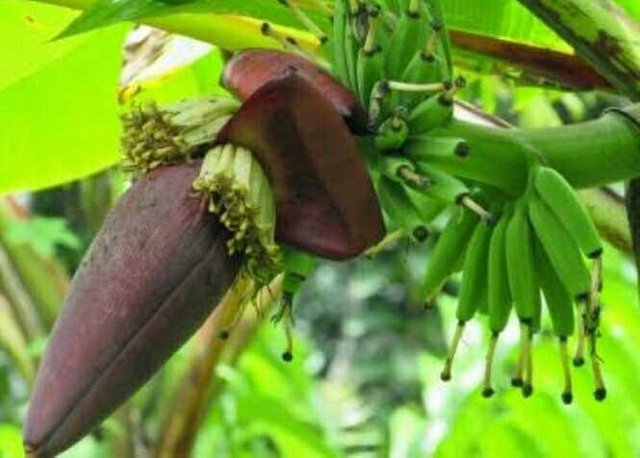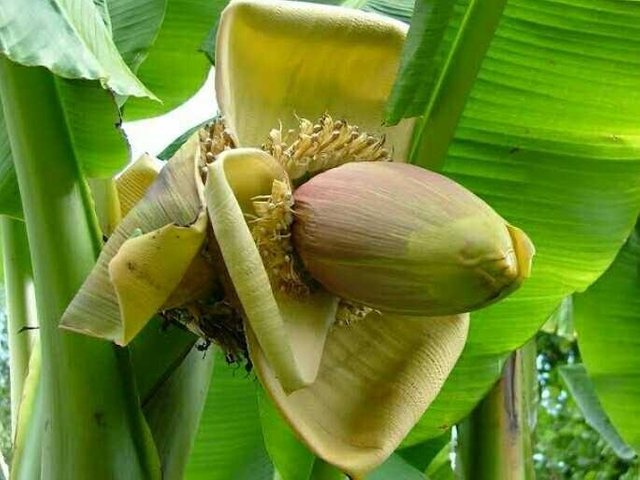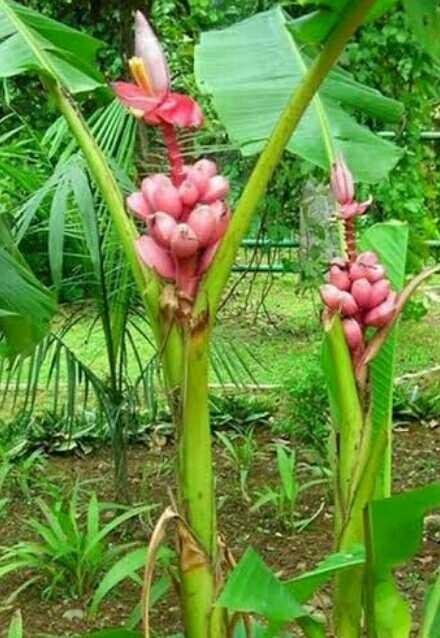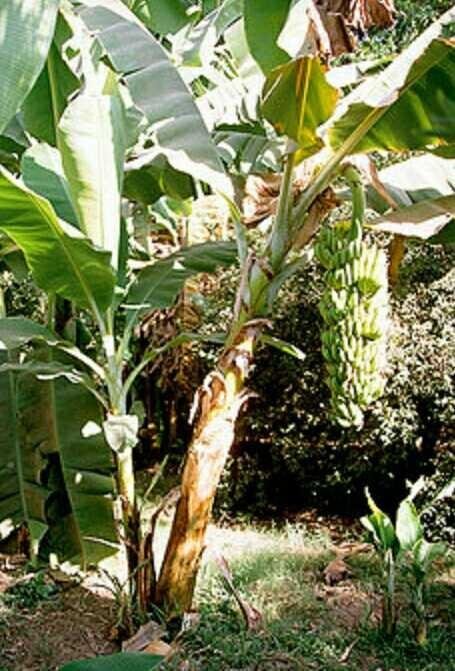Bananas are a common name given to large giant leafy terna plants extending from the Musaceae tribe
Bananas are a common name given to large giant leafy terna plants extending from the Musaceae tribe. Some types (Musa acuminata, M. balbisiana, and M. × paradisiaca) produce fruit of consumption called the same.
The fruit is arranged in clusters with groups composed of fingers called combs. Almost all bananas have yellow skin when ripe, although some are orange, red, green, purple, or even almost black. Banana as a food is a source of energy (carbohydrates) and minerals, especially potassium.

Keep in mind, the term "banana" is also used for a number of species that do not produce fruit consumption, such as abaca bananas, ornamental bananas, and banana fan. This article deals only with fruit-producing bananas and their related relatives.
Banana Diversity Edit
The main banana diversity center is located in the Malesia region (Southeast Asia, Papua and tropical Australia). A minor diversity center is also present in tropical Africa. This plant likes a hot and humid tropical climate, especially in the lowlands. In areas with uneven rainfall throughout the year, banana production can take place regardless of season. Indonesia, Pacific Islands, Central American countries, and Brazil are known as the main exporting countries of bananas. People in African and Latin American countries are known to eat bananas every year.
Theories about the genetic diversity of cultivated bananas Edit
Current cultivated bananas are considered to be descendants of the diploid and growing wild Moses acuminata. The donated genome is given the symbol A. The natural crossbreeding with Musa balbisiana incorporates a new genome, called B, and causes a variety of banana species. The influence of genome B is mainly seen in the starch content of the higher fruits. In general, genome A contributes to the character of the fruit table (banana), while genome B is toward the banana fruit (plantain). The hybrid M. acuminata with M. balbisiana is known as M. × paradisiaca. Especially for the AAB Group, the name Musa sapientum was used.

Following the advice of Simmonds and Shepherd whose work was published in 1955, the classification of banana cultivation now uses the names of these genomic combinations as the name of the cultivar group. For example, for Cavendish bananas, referred to as Musa (AAA group Dessert subgroup) 'Cavendish'. Under the group still possible division in child-group (subgroup). See also Moses' article for a more in-depth discussion.
Examples
°Group AA (diploid): banana one thousand, banana candle, banana mas
°AAA group (triploid, partenokarp): milk banana, bananito, types of ambon / dew bananas (such as 'Ambon Putih', 'Green Ambon', 'Gros Michel' and 'Cavendish'), bananas
°AAB group (triploid, partenokarp): plantain species, true plantain such as South American 'Silk' cultivars, banana horn
°Group ABB (triploid, partenokarp): banana kepok, banana siam
°AAAB group (tetraploid, partenokarp):
°BB group (diploid):
°BBB Group:
°AABB Group:
°Milk banana (AAA Group)
°Super Banana (Group AA)
Banana horn, Bogor Botanical Garden. A. Bernecker, ± 1830?
Aquaculture Edit

Bananas are traditionally not cultivated intensively. Few are cultivated intensively and heavily in monoculture plantations, such as 'Gros Michel' and 'Cavendish'. Other species are usually planted in clusters in yards, on the edges of other cropland, and riverside.
Pests and diseases Edit

Vegetative propagation makes bananas particularly susceptible to intrusive attacks, due to the narrowness of genetic diversity. A plantation affected by the disease can transmit briefly to its neighboring plantation.
Hama Edit
Cosmopolites sordidus beetle, the cause of black spots on bananas
Disease Edit
1 Disease of Panama
2 Sigatoka disease
3 Blood disease
4 Xanthomonas bacterial wilt disease
5 Painful diseases "in the sense of plants
Usage Edit
Based on the way of consumption of fruit, bananas are grouped into two groups, namely banana table (dessert banana) and banana (plantain, cooking banana). Banana tables are consumed in fresh form after ripe fruit, such as banana ambon, milk, king, thousand, and sunripe. Processed bananas are consumed after being fried, boiled, baked, or rejected, such as banana kepok, siam, cotton, horn, and uli.
Bananas are processed into various products, such as sale, cake, or wine (in Latin America).

In addition to contributing nutrients higher than apples, bananas can also provide energy reserves quickly when needed. Including when the brain is exhausted. Various types of snacks from the relatively popular bananas include Banana Chips from Lampung, Sale pisang (Bandung), Pisang Molen (Bogor), and epe (Makassar).
Bananas have very good nutrients, including providing high enough energy compared with other fruits. Mineral-rich bananas such as potassium, magnesium, phosphorus, iron, and calcium.
Bananas also contain vitamins, namely C, B complex, B6, and serotonin are active as neurotransmitters in the smooth functioning of the brain.
Do not steal/copy-paste other peoples copy (writings).
https://steemit.com/indo-stem/@malemdiwa/the-long-fruit-tastes-good-banana-9cdd3b9f46883
http://osulima.blogspot.nl/2015/04/
This post has received a 0.04 % upvote from @speedvoter thanks to: @steem-norwegia.
Hi steem-norwegia
Thanks for looking at and upvoting my silver mine post.
Have a fantastic day.